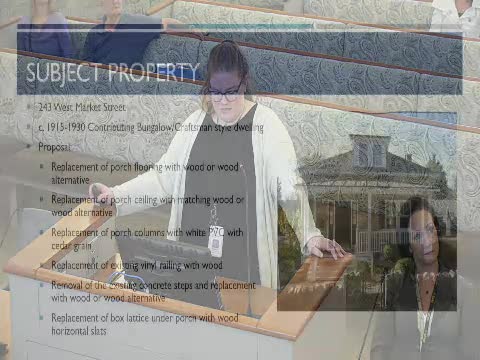Leesburg proposes extensive redesign for historic porch at 243 West Market Street
April 23, 2025 | Leesburg, Loudoun, Virginia
This article was created by AI summarizing key points discussed. AI makes mistakes, so for full details and context, please refer to the video of the full meeting. Please report any errors so we can fix them. Report an error »

In the heart of Leesburg, Virginia, a historic bungalow is at the center of a spirited discussion among the Board of Architectural Review (BAR). During a recent meeting on April 23, 2025, members deliberated over proposed renovations to the home, built between 1915 and 1930, that could significantly alter its architectural character.
The focus of the debate was the front porch, a defining feature of the bungalow's design. The homeowners, represented by Stan Schnippel, presented a plan that included replacing the porch flooring, ceiling, and columns, as well as updating the railings and steps. The proposed changes aim to modernize the porch while maintaining its historical essence, but opinions among board members were divided.
Staff analysis highlighted the importance of preserving the original materials and architectural features of the porch. The guidelines emphasize that alterations should not compromise the integrity of the structure, particularly for a style that is already rare in the historic district. The proposed replacement of the existing Tuscan columns with trapezoidal ones raised concerns, as it could detract from the bungalow's unique character.
While some elements of the proposal, such as replacing vinyl railings with wood, were deemed acceptable, the suggestion to use modern materials for the porch ceiling and screening was met with skepticism. Board members expressed a preference for traditional box lattice over the proposed horizontal slats, arguing that the latter did not align with the home's historical style.
As the meeting progressed, the board recommended deferring the decision to allow for further discussion on the proposed changes. They urged the homeowners to consider options that would better match the original design, ensuring that any updates would honor the bungalow's historical significance.
The outcome of this meeting underscores the delicate balance between modernization and preservation in historic districts. As Leesburg continues to evolve, the decisions made by the BAR will play a crucial role in maintaining the town's architectural heritage for future generations.
The focus of the debate was the front porch, a defining feature of the bungalow's design. The homeowners, represented by Stan Schnippel, presented a plan that included replacing the porch flooring, ceiling, and columns, as well as updating the railings and steps. The proposed changes aim to modernize the porch while maintaining its historical essence, but opinions among board members were divided.
Staff analysis highlighted the importance of preserving the original materials and architectural features of the porch. The guidelines emphasize that alterations should not compromise the integrity of the structure, particularly for a style that is already rare in the historic district. The proposed replacement of the existing Tuscan columns with trapezoidal ones raised concerns, as it could detract from the bungalow's unique character.
While some elements of the proposal, such as replacing vinyl railings with wood, were deemed acceptable, the suggestion to use modern materials for the porch ceiling and screening was met with skepticism. Board members expressed a preference for traditional box lattice over the proposed horizontal slats, arguing that the latter did not align with the home's historical style.
As the meeting progressed, the board recommended deferring the decision to allow for further discussion on the proposed changes. They urged the homeowners to consider options that would better match the original design, ensuring that any updates would honor the bungalow's historical significance.
The outcome of this meeting underscores the delicate balance between modernization and preservation in historic districts. As Leesburg continues to evolve, the decisions made by the BAR will play a crucial role in maintaining the town's architectural heritage for future generations.
View full meeting
This article is based on a recent meeting—watch the full video and explore the complete transcript for deeper insights into the discussion.
View full meeting
